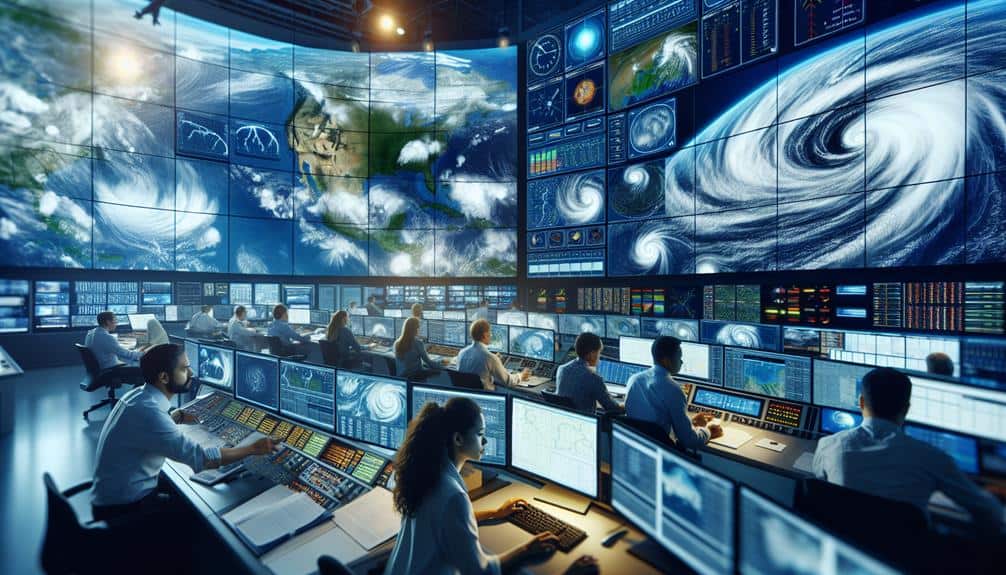We've gathered compelling data revealing the undeniable connection between hurricanes and climate change. Rising global temperatures and higher ocean heat levels fuel more intense and longer-lasting storms. Historical data shows an increase in storm severity and regional disparities driven by a warming climate. Technological advancements, like high-resolution satellite imagery and predictive modeling, enhance our understanding and forecasting of these phenomena. As we analyze wind speeds, pressure changes, and precipitation, it's clear hurricanes have grown more destructive. Exploring mitigation strategies like stronger building codes and early warning systems can further illuminate this critical issue.
Key Points
- Rising global temperatures correlate with increased hurricane severity and frequency.
- Warmer ocean waters fuel more intense and longer-lasting hurricanes.
- Historical data reveals a discernible increase in storm intensity post-2010.
- Advanced predictive models show stronger hurricanes due to climate change.
The Role of Storm Chasers
Storm chasers play a pivotal role in collecting real-time data that enhances our understanding of hurricanes and their relationship with climate change. By chasing storms, we gather essential information about wind speeds, pressure changes, and precipitation patterns. This data helps us analyze the intensity and frequency of these extreme weather events, which is crucial for improving predictive models.
Our pursuit of extreme weather isn't just about the thrill; it's about contributing to a larger body of scientific knowledge. With each storm, we deploy a range of instruments like Doppler radar, anemometers, and GPS devices to capture detailed metrics. This data is invaluable for climatologists who examine how rising sea temperatures and atmospheric changes influence hurricane formation and behavior.
Moreover, the real-time data we collect offers immediate insights that satellite imagery and remote sensing can't always provide. By being on the ground, we can document the storm's impact on local ecosystems and infrastructure, offering a more thorough view.
This on-the-spot data collection is essential for developing adaptive strategies, ensuring that communities are better prepared for future extreme weather events influenced by climate change.
Historical Hurricane Data
Analyzing historical hurricane data allows us to identify trends and correlations that illuminate how these storms have evolved over time. By examining decades of records, we can perform data analysis to understand changes in hurricane intensity and frequency.
Historical data provides a robust foundation to examine patterns and deviations, giving us valuable insights into the behavior of these powerful natural events.
Over the past century, we've seen varying trends in hurricane frequency. Some decades exhibit a higher number of storms, while others appear relatively calm. However, it's not just the number of hurricanes that matters but also their intensity.
When we explore this data, we notice a discernible increase in the severity of these storms. Metrics such as peak wind speeds and minimum central pressures indicate a trend toward more intense hurricanes.
Our data analysis also reveals regional disparities in hurricane activity. Certain areas experience a higher frequency of storms, and understanding these patterns helps us prepare and respond more effectively.
Climate Change Indicators
We've observed that rising global temperatures and increased ocean heat are key indicators of climate change. Data shows that global average temperatures have increased by 1.2°C since the late 19th century, and ocean heat content has reached record levels.
These trends are critical for understanding the link between climate change and the intensification of hurricanes.
Rising Global Temperatures
Rising global temperatures serve as a critical indicator of climate change, with data showing a consistent upward trend over the past century. We've observed that this rise correlates strongly with increased levels of greenhouse gases in the atmosphere. According to the Intergovernmental Panel on Climate Change (IPCC), global surface temperatures have risen approximately 1.09 degrees Celsius since the late 19th century. This increase isn't just a number; it has real-world consequences, leading to more extreme weather events.
Our analysis reveals that the frequency and intensity of natural disasters, such as hurricanes, are closely tied to these rising temperatures. For example, the intensity of hurricanes has increased, leading to higher environmental impact and more significant damage to coastal areas. These changes aren't isolated; they're part of a broader trend linked to the warming climate.
Data from NASA and NOAA confirm that the hottest years on record have all occurred since 2010, underscoring the urgency of addressing climate change. As temperatures continue to rise, we can expect more frequent and severe natural disasters, emphasizing the need for proactive measures to mitigate environmental impact.
Increased Ocean Heat
In addition, the increase in global temperatures has led to heightened ocean heat, which serves as a significant indicator of climate change. Ocean temperatures have been steadily rising over the past few decades, and this warming trend isn't only concerning but also quantifiable.
According to NOAA, the average global sea surface temperature has risen by approximately 0.13°F per decade over the last 100 years. This rise in ocean heat isn't simply a statistic; it has real-world implications.
When ocean temperatures increase, we observe a direct impact on the frequency and intensity of extreme weather events, especially hurricanes. Warmer waters supply more energy for storms, making them more powerful and more damaging. We've witnessed that hurricanes now tend to maintain their intensity for longer periods, often leading to more destruction when they reach land.
For example, Hurricane Harvey in 2017 was fueled by unusually warm Gulf waters, resulting in unparalleled rainfall and flooding.
Advances in Hurricane Tracking
Recent technological advancements have significantly improved our ability to track and predict hurricane paths with increased precision. Satellite technology now allows us to gather extensive data on storm systems in real-time. We can monitor storm formation, movement, and intensity with exceptional detail. This data collection is vital for storm analysis, helping us understand the mechanisms driving these natural phenomena.
Through the use of high-resolution satellite imagery, we can detect changes in storm intensity more reliably than ever before. The data collected from satellites are integrated into sophisticated models that simulate potential storm trajectories. By analyzing these models, we can predict the likely path and strength of hurricanes with greater accuracy.
Additionally, advances in remote sensing and data analytics enable us to refine our understanding of how environmental factors influence storm behavior. We now have the capability to assess variables such as sea surface temperatures, humidity levels, and wind patterns, which are pivotal in forecasting storm development and progression.
These improvements in hurricane tracking not only enhance our scientific understanding but also empower us to take proactive measures to safeguard communities. With more precise predictions, we can implement timely evacuations and disaster preparedness plans, ultimately reducing the impact of these powerful storms.
Predicting Future Hurricanes

We can better predict future hurricanes by utilizing advanced modeling techniques and analyzing historical weather patterns.
These models incorporate vast amounts of data to simulate possible hurricane scenarios.
Advanced Modeling Techniques
Cutting-edge modeling techniques leverage vast datasets and complex algorithms to predict the trajectory and intensity of future hurricanes with greater accuracy. As we integrate more sophisticated data analysis methods, we can better understand and anticipate the environmental impacts of these powerful storms. By harnessing advanced computational power, we're able to simulate various scenarios and improve our predictive capabilities.
Key elements of these advanced modeling techniques include:
- High-resolution atmospheric models: These provide detailed simulations of weather patterns, capturing the nuances of hurricane formation and movement.
- Machine learning algorithms: By analyzing historical hurricane data, these algorithms can identify patterns and improve predictions.
- Integrated ocean-atmosphere models: These consider the interactions between the ocean and atmosphere, which are essential for accurate forecasting.
- Real-time data assimilation: This involves continuously updating models with current data, enhancing the precision of short-term forecasts.
We focus on these methodologies to bolster our preparedness and response strategies. As the climate continues to evolve, so too must our predictive tools, ensuring that we remain vigilant and proactive in mitigating the impacts of future hurricanes.
Historical Weather Patterns
Analyzing historical weather patterns provides invaluable data for predicting the behavior and frequency of future hurricanes. By examining past trends, we can discern shifts in hurricane intensity and frequency over the decades.
Historical records indicate that hurricane intensity has increased, with more Category 4 and 5 storms forming than in previous decades. These past trends offer critical insights into how future weather events may unfold.
We can also evaluate the long-term impacts of these trends on coastal communities. Historical data reveals that stronger hurricanes cause more widespread damage, affecting infrastructure, economies, and ecosystems. By understanding these long-term impacts, we can better allocate resources for disaster preparedness and mitigation.
Moreover, analyzing past weather events allows us to fine-tune predictive models. These models incorporate data on sea surface temperatures, atmospheric conditions, and other variables that influence hurricane formation. By refining our models based on historical patterns, we improve our ability to predict future hurricanes with higher accuracy.
Mitigation and Adaptation Strategies
Recognizing the increasing frequency and intensity of hurricanes due to climate change, it's imperative to develop robust mitigation and adaptation strategies based on empirical data and predictive models. We need to focus on resilience planning and sustainable development to protect communities and ecosystems.
By analyzing trends and leveraging data, we can implement effective measures that enhance our ability to withstand and recover from these natural disasters.
To achieve this, we should consider the following strategies:
- Implementing stronger building codes: Ensuring that infrastructure can endure high winds and flooding.
- Investing in natural barriers: Preserving and restoring wetlands, mangroves, and coral reefs that act as natural storm buffers.
- Enhancing early warning systems: Utilizing advanced technology for timely and accurate weather forecasts.
- Promoting sustainable development: Encouraging the use of renewable energy sources and reducing carbon footprints.
Frequently Asked Questions
How Do Hurricanes Form in the First Place?
Hurricanes form when ocean temperatures rise, creating warm, moist air. This triggers atmospheric conditions that cause storm development. As the storm intensifies, it becomes a hurricane, driven by the energy from the warm ocean.
What Are the Economic Impacts of Hurricanes?
Hurricanes hit hard, causing countless insurance claims and significant business losses. We see spiraling costs, from property damage to disrupted supply chains. Ultimately, these storms stifle economic freedom, burdening both individuals and industries with financial strain.
How Do Hurricanes Affect Marine Life?
Hurricanes greatly impact ecosystems, causing biodiversity loss in marine environments. They disrupt coral reefs, damage seagrass beds, and displace marine species. This affects food chains and habitats, highlighting the need for resilient conservation strategies.
Can Hurricanes Impact Areas Far From Coastlines?
Yes, hurricanes can impact areas far from coastlines. As they move inland, they can cause severe flooding and wind damage. Our analysis indicates that global climate changes amplify these inland impacts, affecting communities' freedom and safety.
What Safety Measures Should People Take During a Hurricane?
During a hurricane, we should prioritize emergency preparedness by securing supplies and identifying evacuation routes. Data shows timely evacuation and readiness greatly reduce casualties, ensuring our safety while maintaining our freedom to act responsibly.

